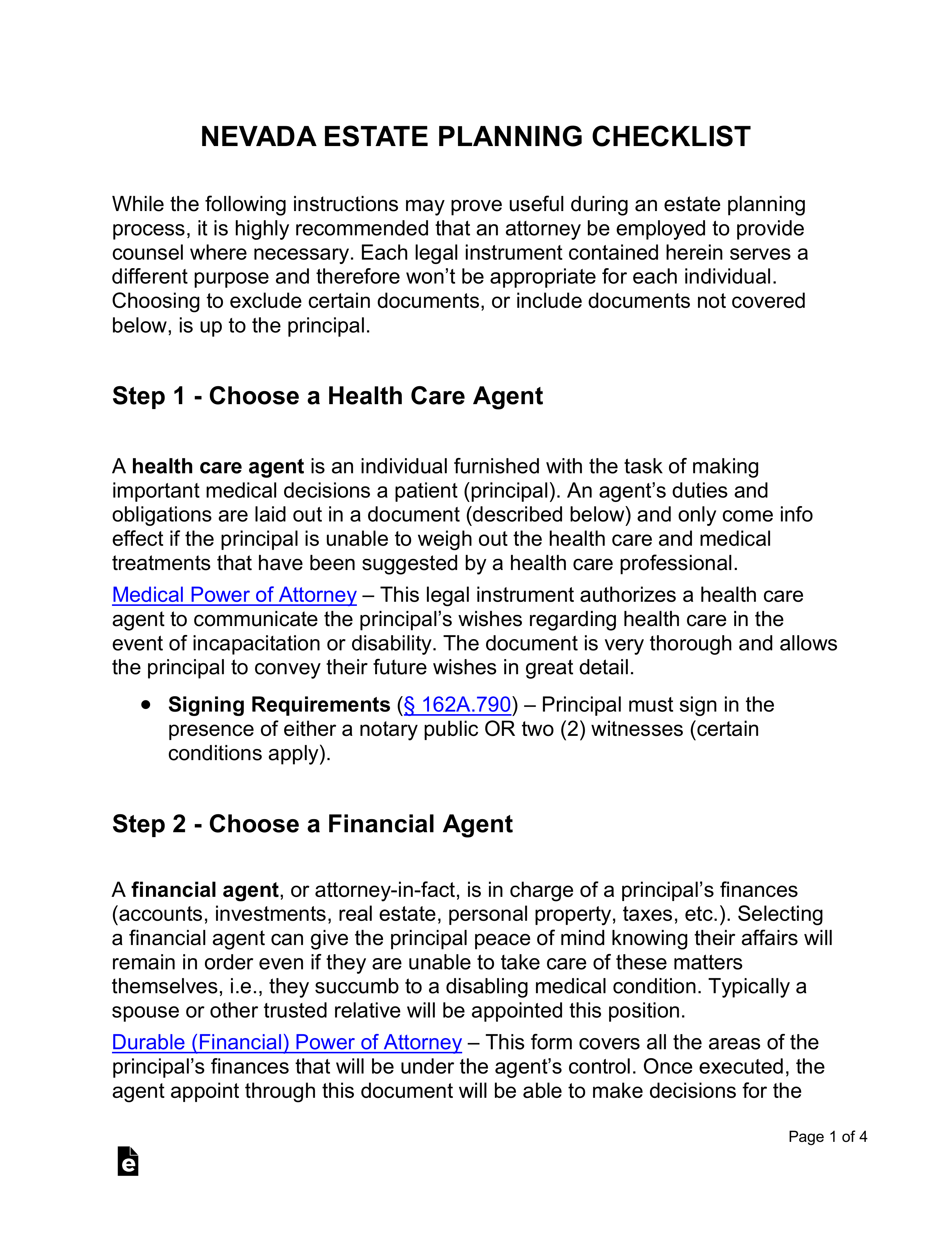Updated March 05, 2024
A Nevada estate planning checklist is a guide for individuals who are attempting to organize their estate and the future of their family. No one expects to die tomorrow, nor does one expect to become incapacitated and unable to make decisions for themselves. In order for a person’s family to have some security, they should draft a Last Will and Testament and/or a Living Trust. These documents will convey a person’s final wishes in regard to the distribution of their estate. For a person’s own peace of mind, creating a Medical Power of Attorney and a Financial Power of Attorney will mean that important decision-making will be left to a trustworthy representative in the event of disability, incapacitation, or death.
How to Create an Estate Plan in Nevada (6 steps)
- Choose a Health Care Agent
- Choose a Financial Agent
- Create List of Assets
- Choose Beneficiaries
- Create Will and/or Living Trust
- Store Documents
While the following instructions may prove useful during an estate planning process, it is highly recommended that an attorney be employed to provide counsel where necessary. Each legal instrument contained herein serves a different purpose and therefore won’t be appropriate for each individual. Choosing to exclude certain documents, or include documents not covered below, is up to the principal.
1. Choose a Health Care Agent
A health care agent is an individual furnished with the task of making important medical decisions for a patient (principal). An agent’s duties and obligations are laid out in a document (described below) and only come into effect if the principal is unable to weigh out the health care and medical treatments that have been suggested by a health care professional.
Medical Power of Attorney – This legal instrument authorizes a health care agent (attorney-in-fact) to communicate the principal’s wishes regarding health care in the event of incapacitation or disability. The document is very thorough and allows the principal to convey their future wishes in great detail.
- Signing Requirements – Principal must sign in the presence of either a notary public OR two (2) witnesses (certain conditions apply).[1]
2. Choose a Financial Agent
A financial agent, or attorney-in-fact, is in charge of a principal’s finances (accounts, investments, real estate, personal property, taxes, etc.). Selecting a financial agent can give the principal peace of mind knowing their affairs will remain in order even if they are unable to take care of these matters themselves, i.e., they succumb to a disabling medical condition. Typically a spouse or other trusted relative will be appointed this position.
Durable (Financial) Power of Attorney – This form covers all the areas of the principal’s finances that will be under the agent’s control. Once executed, the agent appointed through this document will be able to make decisions for the principal whether or not the principal is capable of making their own decisions. That is, the document becomes effective immediately once signed by the principal (unless specifically mentioned in the POA) and remains effective in the event of incapacitation.
- Signing Requirements – Principal must sign in the presence of a notary public.[2]
Financial Powers Allowed:
- Real property[3]
- Tangible personal property[4]
- Stocks and bonds[5]
- Commodities and options[6]
- Banks and other financial institutions[7]
- Operation of entity or business[8]
- Insurance and annuities[9]
- Estates, trusts and other beneficial interests[10]
- Claims and litigation[11]
- Personal and family maintenance[12]
- Benefits from governmental programs or civil or military service[13]
- Retirement plans[14]
- Taxes[15]
- Gifts[16]
3. Create List of Assets
4. Choose Beneficiaries
5. Create Will and/or Living Trust
A principal has a big decision to make at this juncture of the estate planning process; which document will best suit my needs – a Last Will and Testament or a Revocable Living Trust? Regardless of the answer, one would be wise to seek legal counsel before executing any documents.
Last Will and Testament – A Will is a legal instrument that contains the testator’s (principal) instructions regarding the distribution of their estate and other assets after they die. Furthermore, it covers how their debts, taxes, and liabilities should be taken care of, and who will be guardians to their children (if applicable). After the testator’s death, a Will must be reviewed in probate court to verify its validity and authenticity before the executor can hand over the assets to the beneficiaries.
- Signing Requirements – The principal and two (2) witnesses.[17]
Revocable Living Trust – A Living Trust is more than just a set of instructions, it is an entity set up by the grantor (principal) into which property will be transferred. Transferring ownership of certain assets to the Trust means that once the grantor dies, the assets will be bestowed upon the named beneficiaries without going through probate and without being made public record. The grantor will continue to benefit from all assets within the Trust and they can amend this document at any point during their lifetime. Any asset or property not placed under the ownership of the Trust should be included into a Last Will and Testament to ensure that it falls into the right hands after the grantor dies.
- Signing Requirements – Although it is not specifically mentioned in State law, a Living Trust should be signed in the presence of a notary public.
6. Store Documents
Nevada Estate Planning Laws
- Durable Power of Attorney for Health Care Decisions – § 162A.700 et. al.
- Power of Attorney Uniform Act – § 162A.200(-660)
- Last Will and Testament – NRS 133
- Trusts – NRS 163


